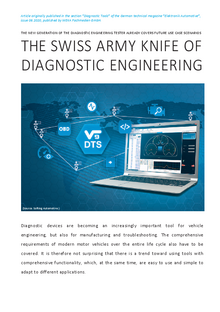Diagnostic Tool Set – Reliable communication in the vehicle
Softing DTS allows the creation of diagnostics and communication in the vehicle.
The Diagnostic Tool Set enables developers, engineers and technicians to create consistent diagnostic functions and sequences based on international standards as well as to ensure that diagnostic communication works reliably over the entire value chain.
Areas of Application
- All possible applications of diagnostics in Engineering, Testing, Manufacturing and Service
- For manufacturers of cars, trucks, buses, motorcycles and non-road mobile machinery as well as tier 1 system suppliers and ECU suppliers
Advantages
- Significant cost reduction in comparison to proprietary developments
- Highly effective because diagnostics only has to be implemented once in the entire value chain
- Future-proof as based on current international standards
- Top quality thanks to data verification and early detection and remedy of communication problems and function errors
Softing DTS – Tool Family for Reliable Vehicle Communication
Internationally standardized
All the major vehicle manufacturers worldwide, together with their suppliers, worked on specifying and implementing a range of international standards. A standardized diagnostic runtime system is a central element in vehicle diagnostics. This ISO MVCI server makes it possible to use vehicle interfaces (VCIs) from different manufacturers and exchange them at will. The standardized data format for specifying and exchanging diagnostic data is ODX. It is independent of the bus protocols used and comprises not only the vehicle- and ECU-specific diagnostic functions ("services") but also configuration and flash data. All ECU variants, based on a standard variant, are included. Redundancies are avoided with the use of libraries, inheritance and references. The actual applications use the methods made available at the application interface. This means that they can be created without there being any need for users to have special knowledge of communication protocols or services and that they are independent of VCI and the protocols used. ECU and vehicle information is accessed using the conversion methods, service and data type descriptions contained in the ODX database. It is also possible to address a request to all ECUs of a functional group with comprehensive functionality, such as for example OBD.
Standards
- Communication server: ISO MVCI-Server/ASAM MCD runtime system (COS)
- ODX data interface: ISO 22901-1/ASAM MCD-2D
- Programming interface: ISO 22900-3/ASAM MCD-3D
- VCI access interface: ISO 22900-2 (D-PDU API) via CAN/-FD, K-line, Ethernet
- ISO 13400 (DoIP)
- ISO13209 (OTX)
- ISO 14229 (UDS)
- ISO 14230 (KWP2000)
- ISO 15031 (OBD)
- ISO 15765
- ISO 27145 (WWH-OBD)
- SAE J2534
- SAE J1939
- and many more
Extended Diagnostic Runtime System
But in vehicle diagnostics, not only individual services but also a large number of diagnostic and test sequences are required over and over again throughout the entire life cycle. These more complex sequences including possible user interaction cannot be described using ODX. This gap in vehicle diagnostics was closed by OTX, another standardized data format which can be run directly over an additional OTX runtime directly based on the diagnostic runtime system. The Diagnostic Tool Set comprehensively covers the vehicle diagnostics by merging ODX with OTX.
Technical Information
| Technical Data | |
| Standard compliance, e.g. | ISO 22901-1/ASAM MCD-2D, ODX V2.2.0 and 2.0.1 (Open Diagnostic Data Exchange), ISO 22900-3/ASAM MCD-3D V3.0.0 programming interface, ISO 22900-2/D-PDU API via CAN, K-line and Ethernet (ISO 13400 DoIP/Tester - Gateway), ISO 13209/OTX V1.0.0 (Open Test Sequence Exchange) |
| VCI support | All VCIs according to the corresponding revision of the data sheet Softing D-PDU API, Other VCIs: All with ISO standard compliant D-PDU API software (release test required possibly), Parallel communication: depending on type and combination ≤ 4 diagnostic interfaces (more on request) |
| Simulated Interface | Enables the diagnostic functions to be tested even without an ECU |
| Protocol templates within scope of delivery | As base for protocol tests and the creation of ECU data in accordance with ISO 22900-2/D-PDU API: ISO_14230_3_on_ISO_15765_2, ISO_14230_3_on_ISO_14230_2, ISO_OBD for K-line and CAN, ISO_15765_3_on_ISO_15765_2, ISO_14229_5_on_ISO_13400_2, SAE_J1939_73_on_SAE_J1939_21, WWHOBD_on_CAN (ISO_27145_3_on_ISO_15765_2) |
| Databases within scope of delivery | OBD database in accordance with ISO 15031-5/SAE J1979:2012-02 for gasoline/diesel vehicles, J1939 database in accordance with SAE J1939, Sample database with three ECU and detailed documentation |
| Runtime data formats | SOD: editable runtime format, which can be exported back to ODX SRD: „monolithic“ ultra-compact runtime format with closed database as with ODX/SOD, SMR: Modular* ultra-compact runtime format (* .. for ODX categories/single ECU), Ultra-compact runtime formats: Vehicle and flash data are 60 to 180 times more compact in comparison to ODX data (depending on OEM/data structure); optional OEM specific encryption |
| Operating systems | Windows 10 (64-bit), Windows 11 (64-bit) |
| General PC requirements | Processor: type and clock (≥ 1.5 GHz) depending on the system configuration and complexity of ODX data, RAM: ≥ 2 GB– depending on ODX data, For hardware interfaces: PCI-/PCMCIA slot, USB-/LAN port, wireless LAN or Bluetooth for HW interface, For optional USB Dongle: USB port |
Technical Articles
Recent Posts
Downloads
| Downloads | |
| Data Sheet | Diagnostic Tool Set – System Overview |
| Flyer | Flash Solutions by Softing |
















